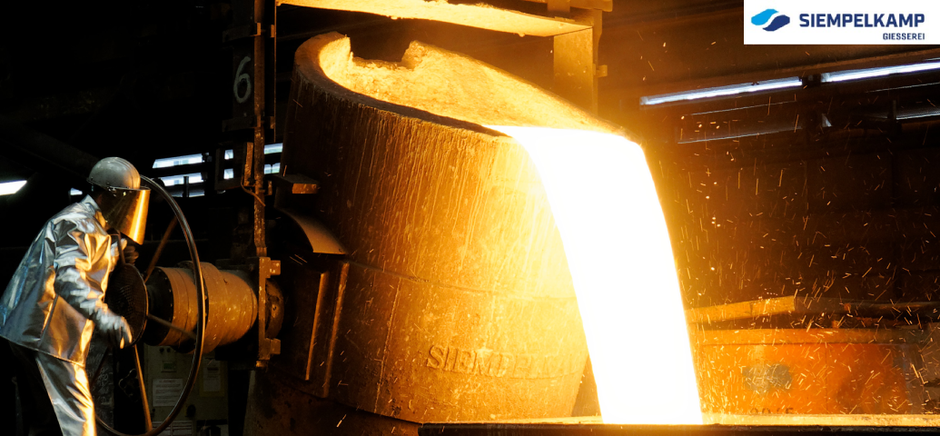Krefeld/Düsseldorf, November 2025 – From the perspective of Siempelkamp Foundry, the Federal Government’s announcement of a planned industrial electricity price raises expectations that cannot be fulfilled under the new EU state aid framework CISAF (Clean Industrial Deal State Aid Framework). Neither is an effective electricity price of 5 ct/kWh achievable for energy-intensive companies, nor does it create meaningful relief. In addition, the limited duration and additional decarbonisation requirements further increase uncertainty for companies. After the coalition committee meeting on 13 November, Federal Chancellor Friedrich Merz announced an industrial electricity price for the years 2026 to 2028 with a “target price of approximately 5 ct/kWh”. At the same time, he emphasised that discussions with the EU Commission regarding state aid approval were well advanced.
However, the decisive point is that the EU framework only makes a limited share of electricity consumption eligible for aid, caps the relief on the energy price, and prescribes minimum prices as well as maximum aid amounts. The new EU state aid framework CISAF simply does not permit a genuine industrial electricity price of 5 ct/kWh for energy-intensive companies. Only part of the consumption is eligible, the amount of relief and the eligible price are limited – and a large portion of the supposed relief volume must be mandatorily reinvested in decarbonisation. Even if a target value of 5 ct/kWh were applied for the aid-eligible share, this would not result in a company-wide electricity price of 5 ct/kWh. What remains is a bureaucratic mini-relief programme without substantial impact on the economy.
Rough calculation reveals the limitations of the industrial electricity price
“The political promises sound like a major breakthrough, but the EU CISAF framework effectively prevents an industrial electricity price of 5 ct/kWh. Instead, energy-intensive SMEs are left only with a highly limited and extremely bureaucratic form of relief. This measure will not significantly strengthen competitiveness, nor will it trigger a shift in the dramatic situation of the manufacturing industry,” says Dirk Howe, Managing Director of Siempelkamp Foundry. No company in this country will ever see 5 ct/kWh on its electricity bill.
A first rough calculation by the two Managing Directors of Siempelkamp Foundry illustrates why the announced industrial electricity price under CISAF does not lead to real cost relief for energy-intensive SMEs.
Starting from an average spot market price of around 80 EUR/MWh (8 ct/kWh), the maximum utilisation of CISAF would allow only a theoretical reduction of the energy component by around 38 percent. Since, however, only half of the electricity consumption is eligible for aid, the relief shrinks to below 20 percent of pure electricity costs. Added to this is the fact that grid fees, taxes and levies will continue to rise in the coming years, meaning that the pure electricity price will only account for roughly half of total electricity costs in the medium term. Mathematically, this means: total relief falls to below ten percent of overall electricity costs.
Half of the subsidy must be reinvested in sustainable corporate transformation
Furthermore, CISAF requires that half of the aid be reinvested in decarbonisation measures. Money originally intended for cost relief and competitiveness is therefore, in effect, not available. Previous ecological counter-requirements have already shown that this comes with complex application processes, detailed documentation obligations and considerable consulting and expert costs. A portion of the nominal relief is thus directly consumed by additional administrative effort. As a result, companies are ultimately left with only a mid single-digit percentage of their electricity costs as actual relief. “If Germany has electricity costs that are multiple times higher than those of our international competitors, then a discount in the single-digit percentage range is nothing more than a drop on a hot stone,” says Dr. Geier.
Call for long-term perspective for the energy-intensive industry
In addition, the industrial electricity price has explicitly been announced only for the years 2026 to 2028. CISAF permits price relief within this framework only for a period of up to three years. This limit is already exhausted by the newly announced concept. Long-term investment decisions therefore cannot rely on a stable, predictable electricity price perspective.
What the energy-intensive SME sector needs is not symbolic politics but a reliable, long-term and internationally competitive energy policy that provides security and planning certainty. Only then can the necessary transformation toward decarbonisation and digitalisation be tackled with confident investments.
Dirk Howe emphasises: “Anyone who believes that the energy-intensive and manufacturing industry can become internationally competitive again under these conditions confuses political announcements with economic reality. What remains is the impression that Germany, in perhaps the most critical phase in decades, offers the energy-intensive and manufacturing industry relief in the per-mille range – yet publicly sells it as an industrial policy breakthrough.”
About Siempelkamp
Siempelkamp Foundry in Krefeld specialises in the production of hand-moulded large castings of up to 320 tonnes made of ductile iron and, with an output of over 60,000 tonnes per year and 400 employees, is one of the largest hand-moulding foundries in the world. Its comprehensive, customer-focused service portfolio includes the supply of structural components for many innovative machinery manufacturers in the energy sector, raw materials industry, press construction, steel production, automotive sector and many other transformation-driven industries. Siempelkamp is an internationally active corporate group with the business units machinery and plant engineering, casting technology, and engineering and service. Nearly 3,000 employees worldwide ensure that the Siempelkamp Group remains positioned among the global technology leaders.









